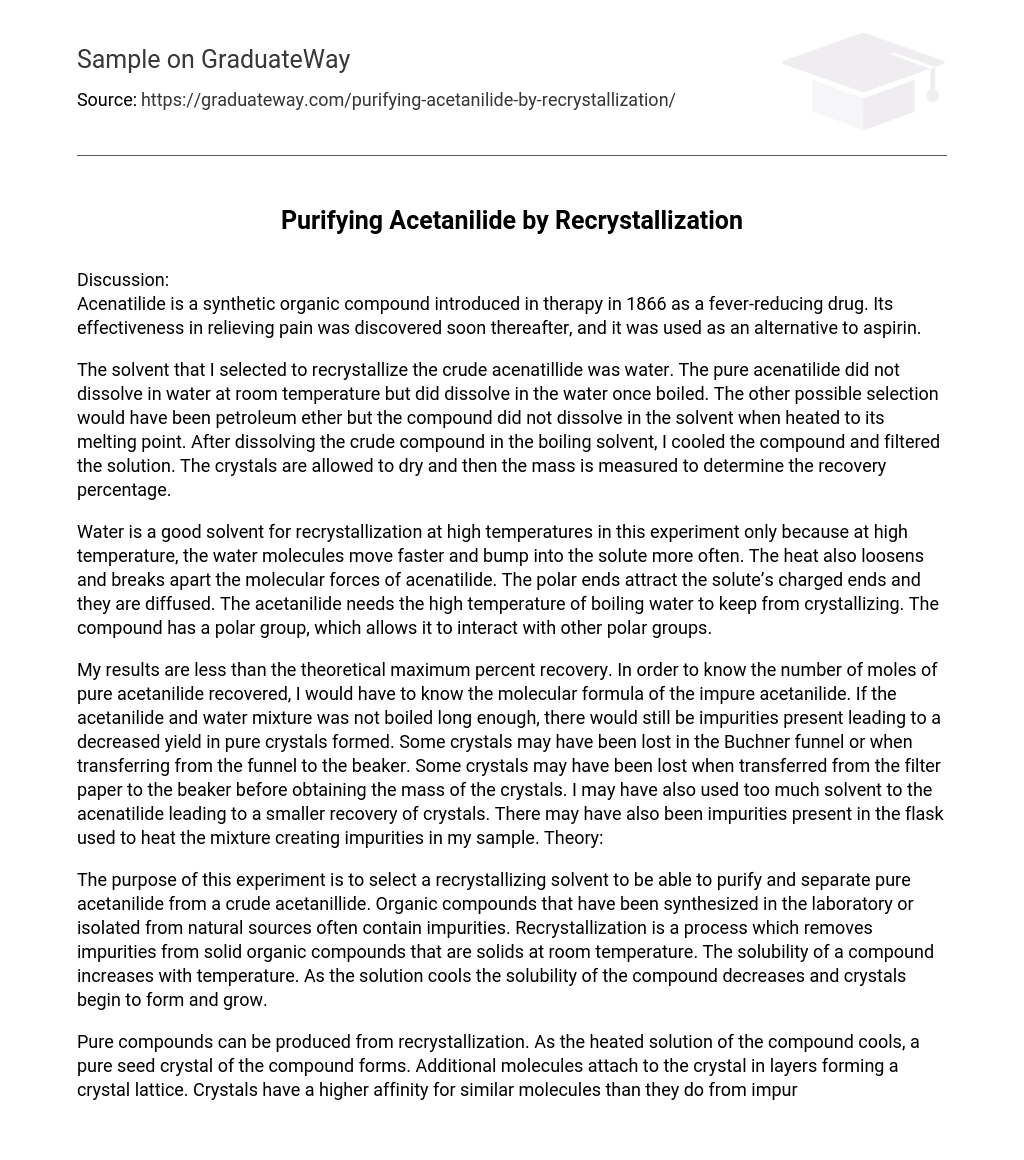Discussion:
Acenatilide is a synthetic organic compound introduced in therapy in 1866 as a fever-reducing drug. Its effectiveness in relieving pain was discovered soon thereafter, and it was used as an alternative to aspirin.
The solvent that I selected to recrystallize the crude acenatillide was water. The pure acenatilide did not dissolve in water at room temperature but did dissolve in the water once boiled. The other possible selection would have been petroleum ether but the compound did not dissolve in the solvent when heated to its melting point. After dissolving the crude compound in the boiling solvent, I cooled the compound and filtered the solution. The crystals are allowed to dry and then the mass is measured to determine the recovery percentage.
Water is a good solvent for recrystallization at high temperatures in this experiment only because at high temperature, the water molecules move faster and bump into the solute more often. The heat also loosens and breaks apart the molecular forces of acenatilide. The polar ends attract the solute’s charged ends and they are diffused. The acetanilide needs the high temperature of boiling water to keep from crystallizing. The compound has a polar group, which allows it to interact with other polar groups.
My results are less than the theoretical maximum percent recovery. In order to know the number of moles of pure acetanilide recovered, I would have to know the molecular formula of the impure acetanilide. If the acetanilide and water mixture was not boiled long enough, there would still be impurities present leading to a decreased yield in pure crystals formed. Some crystals may have been lost in the Buchner funnel or when transferring from the funnel to the beaker. Some crystals may have been lost when transferred from the filter paper to the beaker before obtaining the mass of the crystals. I may have also used too much solvent to the acenatilide leading to a smaller recovery of crystals. There may have also been impurities present in the flask used to heat the mixture creating impurities in my sample. Theory:
The purpose of this experiment is to select a recrystallizing solvent to be able to purify and separate pure acetanilide from a crude acetanillide. Organic compounds that have been synthesized in the laboratory or isolated from natural sources often contain impurities. Recrystallization is a process which removes impurities from solid organic compounds that are solids at room temperature. The solubility of a compound increases with temperature. As the solution cools the solubility of the compound decreases and crystals begin to form and grow.
Pure compounds can be produced from recrystallization. As the heated solution of the compound cools, a pure seed crystal of the compound forms. Additional molecules attach to the crystal in layers forming a crystal lattice. Crystals have a higher affinity for similar molecules than they do from impurities in the solution, removing impurities from the mixture.
We selected a suitable recrystallizing solvent from water, ethane, acetone and petroleum ether. A suitable solvent should dissolve the pure acetinillide at increased temperatures but not completely soluble in the cold solvent. After selecting the solvent, a sample of crude acetinillide is dissolved in boiling solvent. The compound is slowly cooled to room temperature then cooled in an ice bath to promote maximum crystal growth formation.
Lastly, the crystals are recovered through vacuum filtration, dried, and their mass recorded. The major criteria for an ideal recrystallizing solvent are that the compound must be insoluble in the solvent at room temperature, must be soluble at high temperature, the boiling point must be lower than that of the compound, and an abundant amount of crystals must be recovered from the cool solvent.
Post-Laboratory Questions:
1)
(a)
(b)
2)
(a)
(b)
(c) The theoretical maximum percent recovery is not necessarily applicable in my experiment because the percent recovery was reduced during vacuum filtration when the crystals were washed in the ice cold water.
3)
(a) The addition of excess solvent prevents the recrystallization of the solutes when the solution cools, causing the loss of pure product and a lower percent recovery. (b)The warm solvent is more likely to dissolve the crystals making the percent recovery less.





